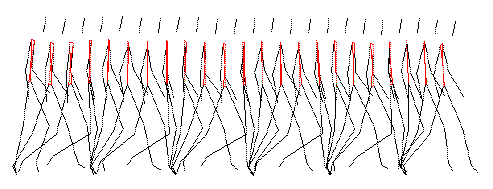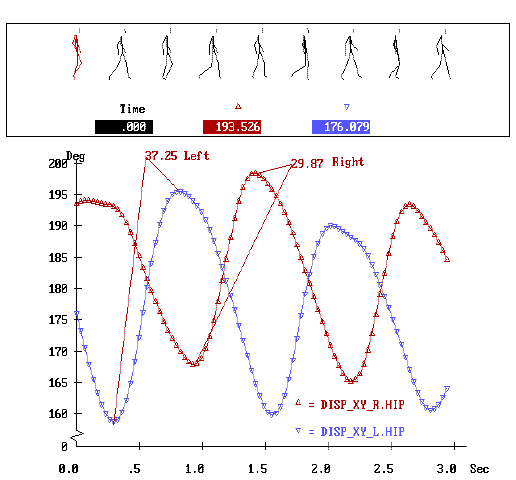The patient is a 44 year old male. He
was involved in a motor vehicle accident. His diagnosis was low back sprain / strain. MRI
imagery revealed Degenerative Disc Disease L1-2, L2-3, L4-5. His current complaints were,
chronic pain and intermittent muscle spasms, in the left lower back area. He noted that
these symptoms were exasperated by ambulation. Test Protocol
A test was designed to analyze the kinematics,
kinetics and functional electromyography of the patient's functional ambulation, lift task
capability and balance. Video computerized motion analysis, a walking track force platform
system and multi-channel dynamic electromyography procedures were implemented to gather
the necessary data.
Functional Motion Analysis Results
Kinematic analysis [see Illustration I] revealed
motion abnormalities of dynamic kinematic joint ranges, particularly right hip extension
and left knee extension deficits. This pattern reflects a guarding type of gait.

Illustration I
Side View- Gait Kinematics

Graph I
Dynamic Range of Motion- Right Hip vs. Left Hip
[Note the Right hip extension pattern (red) vs. the Left hip extension pattern
(blue)]
This ambulation pattern confirmed that the patient
was avoiding loading to the left low back region. The patient was leaning away from the
painful left side. The consistency of the dynamic range of motion graphs, from step to
step, confirmed organicity and repeatability of the results [see Graph I]. EMG results
revealed bilaterally, reveal the presence of distinct muscle spasm patterns, consisting of
short, intermittent bursts, immediately following heel strike of the stance phase [see
Graph II].

Graph II
Multi-Channel EMG- Lumbar Paraspinal Muscles
Note the prolonged muscle activity
pattern of the RULP (right upper lumbar paraspinals) and the LULP (left upper lumbar
paraspinals). The sharp burst of muscle activity corresponds Note the prolonged muscle
activity pattern of the RULP (right upper lumbar paraspinals) and the LULP (left upper
lumbar paraspinals). The sharp burst of muscle activity corresponds directly to heel
strike of stance phase during ambulation. This is denoted by the initial vertical force
curve on the green line of the graph.
Outcome
Upper low back paraspinal muscle spasm activity
corresponds to the MRI finding of L1-2, L2-3, Degenerative Disc Disease. The patient's
complaint of pain and muscle spasm was confirmed. The treating physician instituted a
physical therapy program, based on specific functional motion deficits, reflected in the
test results. The treatment was effective in restoring function and reducing pain to a
manageable level. |